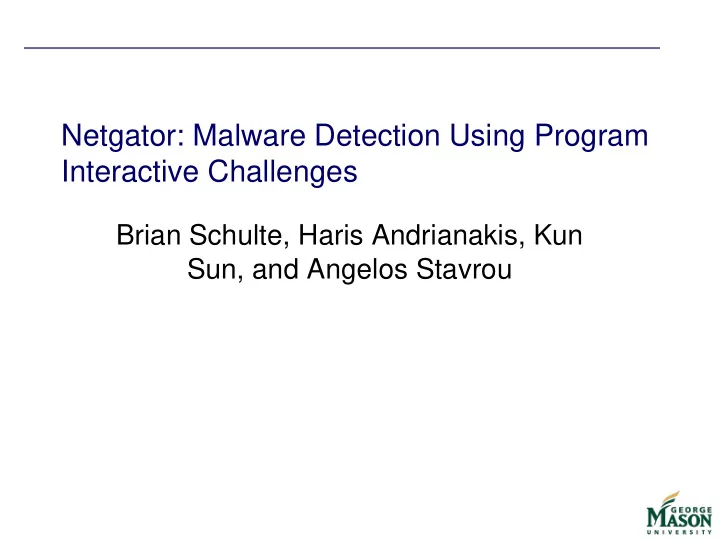

Netgator: Malware Detection Using Program Interactive Challenges Brian Schulte, Haris Andrianakis, Kun Sun, and Angelos Stavrou
Intro Increase of stealthy malware in enterprises Obfuscation, polymorphic techniques Often uses legitimate communication channels HTTP Volume of traffic makes it difficult to process all communications HTTPS Lack of inspection currently Disguised as legitimate applications
Intro Netgator Inspection of legitimate ports/protocols Port 80, HTTP/S Transparent proxy 2 parts Passive Determine type of application Easily catch “dumb” malware Active Challenge based on expected functionality (PICs)
Intro Focus on HTTP/S, browsers Study of 1026 malware samples Out of samples where network activity was observed, ~80% utilized HTTP/S Very high percentage of HTTP/S malware try to masquerade as browsers None passed our challenges
Intro PIC Challenge comprised of a request and expected response pair Communication intercepted Response it sent back to exercise known functionality of advertised program If expected answer is returned, communication is allowed to pass through If not, drop connection
Intro 2 pronged approach Passive to classify traffic Active to “challenge” application Prototype built using HTML, Javascript, and Flash challenges Low overhead 353 ms end-to-end latency
Design and Implementation 2 major parts Passive Active Passive Establish type of application Browser, VOIP, OS updates, etc… Signatures are determined by unique HTTP header orderings
Active Challenge Architecture Proxy & ICAP server duo Squid, HTTP/S transparent proxy Greasyspoon, Java based ICAP server What is ICAP? Internet Content Adaption Protocol Allows modification of all elements of HTTP request/response Body, headers, URL, etc…
Active Challenge Architecture
Active Challenges For known applications, we challenge them based on known functionality For browsers, HTML/Flash/Javascript Challenge code comprised of a redirect to the originally requested file with a hash appended as a parameter To cut down on overhead, text/html data is challenged on the response
Active Challenges Two types Request Response Request challenging Stop the initial communication Send back challenge immediately Higher latency, good protection Response challenging Allow original response to come back Imbed challenge in original response Lower latency, possibly lower security
Active Challenges – Request Challenge
Active Challenges – Request challenging Hash is unique each time Based on time, requesting IP, requested URL, and secret key Headers replaced with HTTP response headers Forces the new response back to the client Challenge code example, Javascript:
Active Challenge – Response Challenge Challenging every request at the request would cause a lot of overhead Challenge text/html data at the response Let the original request pass through Insert challenge inside the original response Client gets response and then challenge is processed
Active Challenge – Response Challenge
Active Challenges The hash is what tells the proxy if the application passed the challenge Attacker can just parse out hash Encrypt the hash with a Javascript implementation of AES The challenge that is sent back now contains the code (and key) to decrypt the hash Forces the attacker to have a full Javascript engine to decrypt the hash
Active Challenges – Handling SSL Squid’s SSL-bump utilized Traffic encrypted with Netgator’s key Decrypted at proxy for processing Re-encrypted with external site’s key when leaving proxy
Active Challenges Further cutting down on overhead Automatically pass network requests if the client has passed a challenge for that site’s domain Client has passed challenge for www.foo.com Request for www.foo.com/bar passes automatically Records are periodically cleaned Avoid malware “piggy-backing” off legitimate client’s who passed challenges
Experimental Evaluation Used PlanetLab nodes for download tests Downloads of 3 different file sizes 10KB, 100KB, 1MB 3 challenges types HTML, Javascript, Flash Request and Response challenging
Experimental Evaluation
Experimental Evaluation HTML lowest overhead Javascript results Nice middle ground between difficulty to pass challenge and measured overhead Flash results Highest overhead Toughest challenge, combines Javascript and Flash Response challenge results By far the lowest, lower security though since the original response is let through
Discussion Attackers will attempt evasion Using a different user-agent/header signature If unknown, communications are blocked If known, challenge will still be sent Some legitimate applications might not be able to have challenges crafted Whitelist can be created
Related Works Closest to our work is work by Gu et al. Active botnet probing to identify obscure command and control channels Main differences We do not expect nor ever rely on a human to be behind an application’s communications Our work focuses on legitimate applications rather than malicious botnets
Related Works Our work similar to OS and application fingerprinting Nmap CAPTCHA puzzles Instead of focusing on humans, focus on the application Traditional botnet detection BotSniffer, BotHunter, BotMiner
Conclusion Netgator Inline malware detection system 2 parts Passive to classify traffic and thwart “dumb” malware Active to challenge applications identity Program Interactive Challenges Fully transparent to the user Average latency 353ms for request challenges 24ms for response challenges
Recommend
More recommend